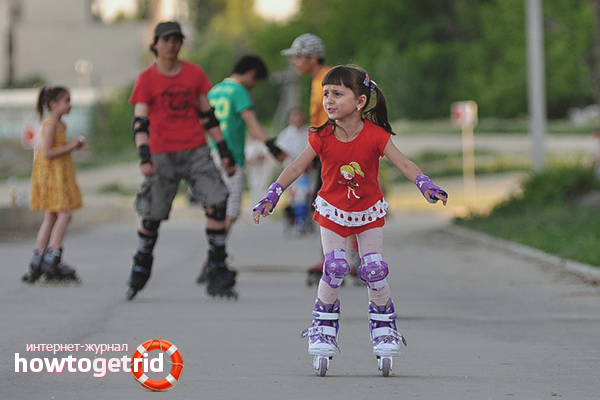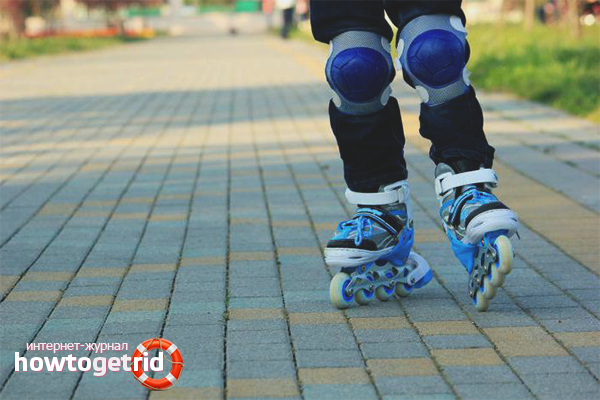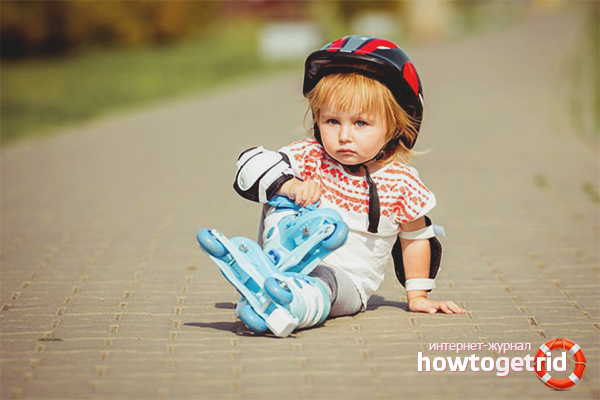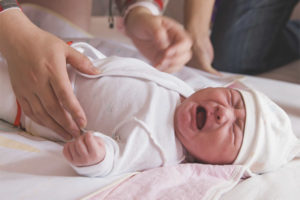The content of the article
Skating on roller skates, as one of the ways of entertainment in the summer and, partly, the autumn season, has remarkably recommended itself both among children and young people, and among adults. This is due primarily to the fact that they can simultaneously have fun while playing various games (for example, hockey on the pavement), and at the same time significantly lose weight, because in the process of driving on rollers almost all the muscles are involved: the main load is taken by the legs, hands are made by repellent-raking movements, imparting impetus to the move, all the muscles of the back “monitor” the correct posture and its position.
Rollers can also serve as a kind of preliminary stage of learning to skate on classic winter figure skating or hockey skates: the principle of movement is absolutely the same, with the exception ofthat the latter require a little more to feel the balance of your own body due to the smaller area of contact between the rubbing elements.
Selection of roller skates
Obviously, the fastest way to learn to ride roller skates is possible only on such skates that provide the best friction and traction on asphalt. Although there is nothing intricate in the construction of the rollers, some manufacturers prefer to save on wheel materials, which leads to the fact that while riding a child on these skates, it shakes the child, as if he is riding on bumps and holes. Since the child is just learning to ride, it is necessary to think in advance about the possibility of installing a brake system on the rollers.
It is important to understand that in contrast to skates, in no case can you buy rollers for growth or for two children at the same time, if only because no one will wear a wool sock in the summer. The internal shape of the roller should, if not exactly, then 95% describe the shape of the foot. The leg should not move within them at least in any direction, even a millimeter or two, it should be firmly fixed in them, as tightly as possible. This is necessary for:
- Quickly gaining the "feeling" of the video and, as a result, the technology.
- Full control over the roller, which is especially necessary in some emergency situations, for example, when you have to turn somewhere sharply.
- Preventing the appearance of corns and plantar warts.
- Increase the time of riding (the stronger the leg is fixed, the less tired the child).
Since the demand for videos is only growing, it is easy to find middle-class brands that meet all the requirements listed above in sports shops. Many coaches in physical training skaters and hockey players, whose students are engaged in the summer on the rollers, advised to purchase products from Roller Blade, Roces, Seba and Powerslide.
If the selected model fits the foot in its length and width, then you should not get skates right there: you should give them a little time to show themselves. The child should at least be a bit like them in the store, literally 10 minutes. If his inexperienced leg is not tired after that, then this will confirm the correctness of the choice, otherwise it is better to try on another pair.
Acquisition of accessories
Very often, sales consultants, seeing that they buy the child for the first time, advise you to purchase various personal protective equipment: knee pads, helmet, elbow cuffs, etc. The choice here should be based on purely individual preferences, since in most cases these tools make the movement more constrained and somewhat uncomfortable, and the children, barely a little further from the gaze of the parents' eyes, immediately remove the disturbing things.
By the way, there is a fairly common opinion that the process of learning roller skating is impossible without falls. It, of course, has the right to life, but it should be borne in mind that it went more due to the fact that earlier the rollers were made of fairly rigid materials, “thanks to” which the frame and the roller itself jumped from the slightest crack in the asphalt. Now the wheels of the skates are much softer and able to calmly bear such irregularities.
The frequency of falls also depends on the skating style chosen by the child: often children try to accelerate as fast as possible on the very first days on the rollers, which, of course, leads to falls and, as a result, injuries, bruises and abrasions.If the child prefers to first make sure of his abilities, then he will not need improved means of protection, the usual kneecaps are enough.
First steps and movements
Before you begin learning to skate directly, you should explain to the child how to stand on his feet so that they do not disperse in different directions. The legs should not be perfectly level, as if standing at attention, but their socks should be directed towards each other at a slight angle. At the same time, one foot should slightly go forward, about five to seven centimeters.
Before you put the rollers on the child, it is important to ensure that he pre-warmed up a bit by doing a couple of squats. This is necessary for a small body, not yet accustomed to such loads.
It was mentioned above that the key to a long and pleasant ride is the correct position of the back, which will distribute the load correctly. So, it is determined by:
- Slightly inclined forward body, as if something must be lifted from a high table;
- Knees bent (in this state, they are ready for sharp turns, turns and other movements);
- Hands stretched forward, alternately replacing each other;
- Being in front of one roller that is leading (it is he who sets the motion vector).
It is very important to explain to the child that one should not be afraid of falling, because everyone, even the most experienced roller skaters, went through it.
At the stage of determining the best position for movement, it is necessary to stop all attempts of the child to bend or move somewhere. If you can see that he is experiencing discomfort, you should directly ask about this (it may be in the rollers, insole, etc.).
To understand how to move, you can use one simple exercise: you should just stand on the rollers and gently lean forward, after bending back. Thus, the child himself will understand exactly how to stand on skates is easiest for him. Once the optimal position is found, you can try to move without the inclusion of hands, holding them just slightly in front, shoulder-width apart. If there are two relatives with a child, then the basics of movement can be mastered even faster: one should only slightly push the child under the shoulders, directing him to another.
In no case can not push the child in the back! This is fraught with loss of balance due to pressure in the lower back and, as a result, falling on the face.
Exercises aimed at improving the technique of riding
As soon as the future scooter realized how to keep balance and not be afraid of a potential fall, you should gradually bring it to a little more complicated exercises that focus on a particular element of skating:
- "Ski videos". The exercise focuses the attention of the child on the sense of the wheels of the roller, helping to understand the principle of their movement. To perform the exercise, one should move the legs in a sliding motion without lifting the heels from the ground, just as they do on recreational skis.
- "Circles". Exercise hones the skill of owning a roller, so that the child finally understands that the horse is literally the continuation of the leg. On the asphalt, you should first draw a few relatively small circles. The starting position is the heels together, the socks are spread apart. The meaning of the exercise is that the child, having mastered the implementation of the previous one, should reach the circle, spread her legs along the length, bending around him. A few laps are necessary for the child to understand that you should not relax for a second. At the end of the route you can make a wide turning semicircle.
- "Eight". A classic exercise familiar to every hockey player: you must move forward, crossing and spreading your legs so that they describe a given number. In fact, the "eight" - a slightly complicated version of the "circles".
- "Snake". This exercise is surely familiar to all parents since passing the exams for car license rights. Its meaning and principle are absolutely identical.
- "Broken". This exercise is a repetition of all the previous ones with the addition of new elements: the goal is to pass a non-smooth route that should describe a broken line in space connecting some points (flags, cones, water bottles, etc.).
It is important to note that the implementation of these exercises is not a universal key to gaining control of your body as a child, but a real practical way to help you understand exactly what can hold down movements and what you need to work harder in the future.
If you take to the exercise at least two days (three to four hours a day), then almost certainly every child will be able to master the principle of movement on rollers.
Braking technique
As soon as the child learned to ride roller skates and reach from one point to another relatively quickly, he would certainly want to feel the speed and experience all the excitement of chasing another scooter. And here there is a very important point: does he know how to properly slow down?
As you know, you can brake on the rollers using a standard brake, which is a plastic, rubberized at the end, arcuate part, which is attached approximately at the level of the ankle and ending at a centimeter distance from the ground (this parameter is adjustable, therefore you can either lift the brake or lower ).
The standard brake is suitable for beginners: it is easy to use it, its installation does not take too much time, and the device is so simple that it simply has nothing to break, therefore it cannot fail. The braking process can be briefly described as follows:
- The roller on which the brake system is fixed is slightly advanced (it is preferable that the brake be installed on the driving leg).
- Gradually, not abruptly, it is necessary to transfer the weight to the heel, as if wishing to stand on it.As soon as he felt the brake touch the ground, the child should continue to brake without fear of possible slight shaking.
Obviously, to abruptly put your foot on the heel with a roller means that in 50% of cases to ensure the flight forward through your head. This can be compared with the abrupt stop of the cyclist, who suddenly decided to use the front brake, and not the rear brake.
But the brake has several drawbacks, the main of which is its gradual abrasion and, as a consequence, the need to acquire a new one. Therefore, each child should be able to slow down and naturally, without using a standard brake system. Below are a number of ways in which you can quickly and effectively slow down:
- Slalom method, which consists in creating your own stopping distance, resembling a snake. The high speed gained at the beginning of the route will be gradually quenched due to the passage of several turns. At the same time, it is desirable for the child to actively use his hands, which will additionally help him to maintain balance.
- Roll out on the lawn or ground. This method to some extent can be attributed to emergency, should be applied only if absolutely necessary. It is also better to master it in advance, as it is fraught with a fall.At the same time, the child should understand that if it was necessary to brake by rolling out, then after it became possible to return to the asphalt, it is necessary to clear the space between the wheels, since the dirt or small stones that have entered can greatly degrade traction.
- Braking yuzom or turn. Enough original braking method, which is to use the leg removed as a carrier barrier. The leg brought forward is placed perpendicularly to the second so that the spinning wheels extinguish the speed through friction with the skid. If it is possible to make a turn, then the first leg can be placed not at a right angle, but under a rather steep one.
Correct fall
Falls are a part of learning to skate, so you should make sure that the child falls correctly so that by chance he doesn’t severely injure the vital organs. The ideal fall is one in which the brunt falls on the knees, and then on the elbows and the rest of the body. When it is much less likely to get a sensitive blow to the head or other important organs.
Always fall forward, in no case on the back! Absolutely all the falls that occur on the back of the body are very sensitive and after a long time remind of themselves.
findings
Since practically any child can be easily distracted, one should competently approach the choice of a place for learning to skate. The more colorful windows, cute trees, ponds and other elements that entice children in the park or on the grounds - the higher the chance that a small roller will learn to ride unconsciously, constantly looking around.
At first, the child should ride with rollers either with the family or in the company of friends, which has already mastered all the principles of movement. Being in such a company, he will again and again try to move his legs in the right way, which will lead to success.
Video: the basics of roller skating















To send